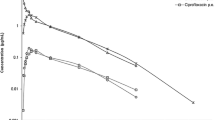Abstract
Veterinary medicine plays a significant role in the development of animal husbandry. Drugs residual in food would follow the food-chain coming into human body, which might bring hidden dangers to people. Chicken is the prime source of meat food, whose quality is important for our life and health. Therefore, it is necessary to realize the withdrawal period and establish an efficient, sensitive and accurate method for monitoring the metabolic process of drugs in chicken body. In this paper, the pharmacokinetics of aminophylline in partridge chicken after intravenous and oral administration was investigated using a sensitive high-performance liquid chromatography method. Plasma concentration–time profiles of aminophylline were analyzed by a non-compartmental model using Topfit 2.0. Following intravenous and oral administration, the peak concentrations (C max) were found to be (16.5 ± 3.0) µg/mL at (0.08 ± 0) h and (7.4 ± 1.5) µg/mL at (1.83 ± 1.11) h, respectively. The elimination half-time (t 1/2) after intravenous and oral administration were, respectively, (13.1 ± 4.17) h and (11.65 ± 1.14) h. Areas under the plasma concentration–time curve (AUC) were (209.6 ± 22.8) µg h mL−1(AUC0–t ) and (219.5 ± 28.3) µg h mL−1 (AUC0→∞ ) after intravenous, and (165.1 ± 37.0) µg h mL−1(AUC0–t ) and (179.3 ± 35.6) µg h mL−1 (AUC0→∞ ) after oral administration. Mean retention time (MRT) after intravenous and oral administration were, respectively, (14.06 ± 0.86) and (15.27 ± 0.62) h. The total clearance rates (CLtol) were (0.77 ± 0.10) mL min−1 kg−1 of intravenous and (0.97 ± 0.20) mL min−1 kg−1 of oral administration. The apparent distribution volume (V d) was (0.87 ± 0.27) and (0.97 ± 0.20) L kg−1, respectively, for intravenous and oral administration. The absolute bioavailability (F) after oral administration was (83.1 ± 11.7) %. The results showed that aminophylline in partridge chickens had a longer elimination half-time, a smaller clearance rate, as well as a higher absolute bioavailability for oral administration. Therefore, aminophylline in partridge chickens produced a long healing efficacy and oral administration can achieve a good absorption which could meet the requirement.




Similar content being viewed by others
References
Cai T, Zhu YG (2007) Determination of theophylline sustained-release tablets by HPLC. Chin Pharm Aff 21(1):47–48
Dai JY (2009) The pharmacological action and clinical application of aminophylline. Chin J Mod Drug Appl 3(2):120–121
He J, Zhou Q (2010) Studies on the relationship between different drug regimens and plasma concentration of theophylline. J Kunming med univ 5:42–45
Li ZS (2010) Studies on pharmacokinetics of aminophylline and the influencing factors. MasterThesis of Shandong University
Li YL, Luo YA (2005) The pharmacological action and clinical application of aminophylline. Her Med 24(9):807–809
Li XP, Zhang CL, Gao P, Liu D (2013) Effects of andrographolide on the pharmacokinetics of aminophylline and doxofylline in rats. Drug Res 63(5):258–262
Liu YF, Chen WM, Chen J (2010) Determination of theophylline and doxofylline in human plasma by HPLC. Chin J Pharm 41(2):131–133
Roberts MS, Magnusson BM, Burczzynski FJ, Weiss M (2002) Enterohepatic circulation: physiological, pharmacokinetic and clinical implications. Clin Pharmacokinet 41:751–790
Shi J, Chen DP, Xiong Y, Tang J, Wu JL, Mu DZ (2013) Investigation on pharmacokinetics of aminophylline in very low birth weight infants. J Sichuan Univ 44(2):291–294
Tang ZH, Wang W, Ding JW (2008) Study on pharmacokinetics of aminophylline in beagles by two administration routes. Chin J Clin Pharm 17(4):244–246
Tian SY, Ai DH, Jiao XY (2012) Pharmacokinetics of aminophylline in rabbits. Seek Med Ask Med 10(7):188–189
Tong SS, Ma LL, Yu JN (2009) Influence of pazufloxacin mesilate on pharmacokinetics of aminophylline in rabbits. Chin Pharm J 12:933–935
Ye L, Jin ML (2009) The research progress of theophylline drugs and its clinical application. Med Monogr 1(4):23–24
Zhou YF (1995) Theophylline’s application in clinic treatment and a check to it. J Southwest Natl College 21(1):107–109
Zhou MY, Chen QC, Fu YZ (2011) Study on pharmacokinetics of aminophylline in rat. Chem Bioeng 28(10):72–74
Acknowledgments
This research was supported by National Science and Technology Support Plan Project of China (2012BAK17B05).
Author information
Authors and Affiliations
Corresponding author
Additional information
B. Yin, J. Li and S. Wang contributed equally to this work.
Rights and permissions
About this article
Cite this article
Yin, B., Li, J., Wang, Sl. et al. Studies on pharmacokinetics and bioavailability of aminophylline in partridge chickens. Eur J Drug Metab Pharmacokinet 41, 19–25 (2016). https://doi.org/10.1007/s13318-014-0225-6
Received:
Accepted:
Published:
Issue Date:
DOI: https://doi.org/10.1007/s13318-014-0225-6




